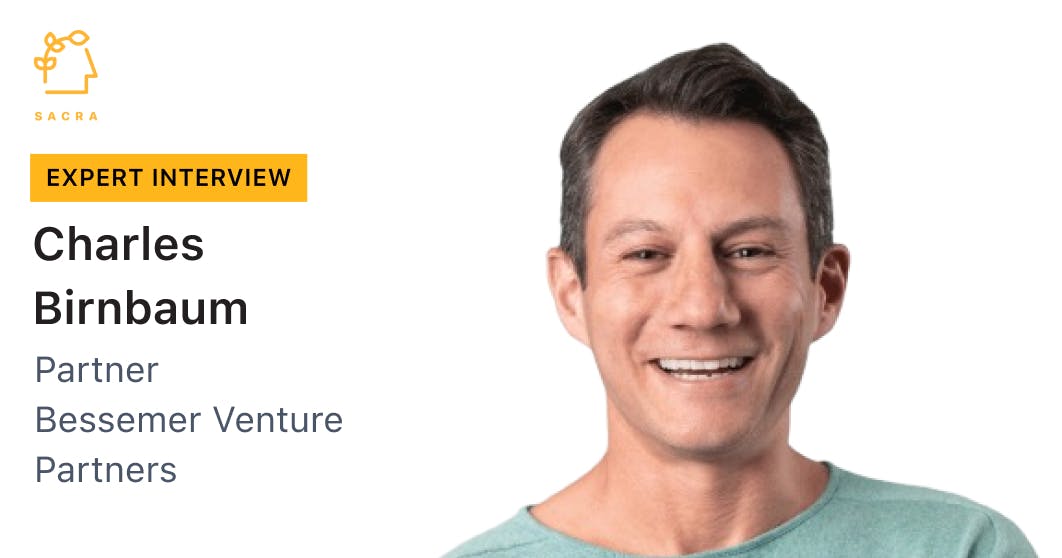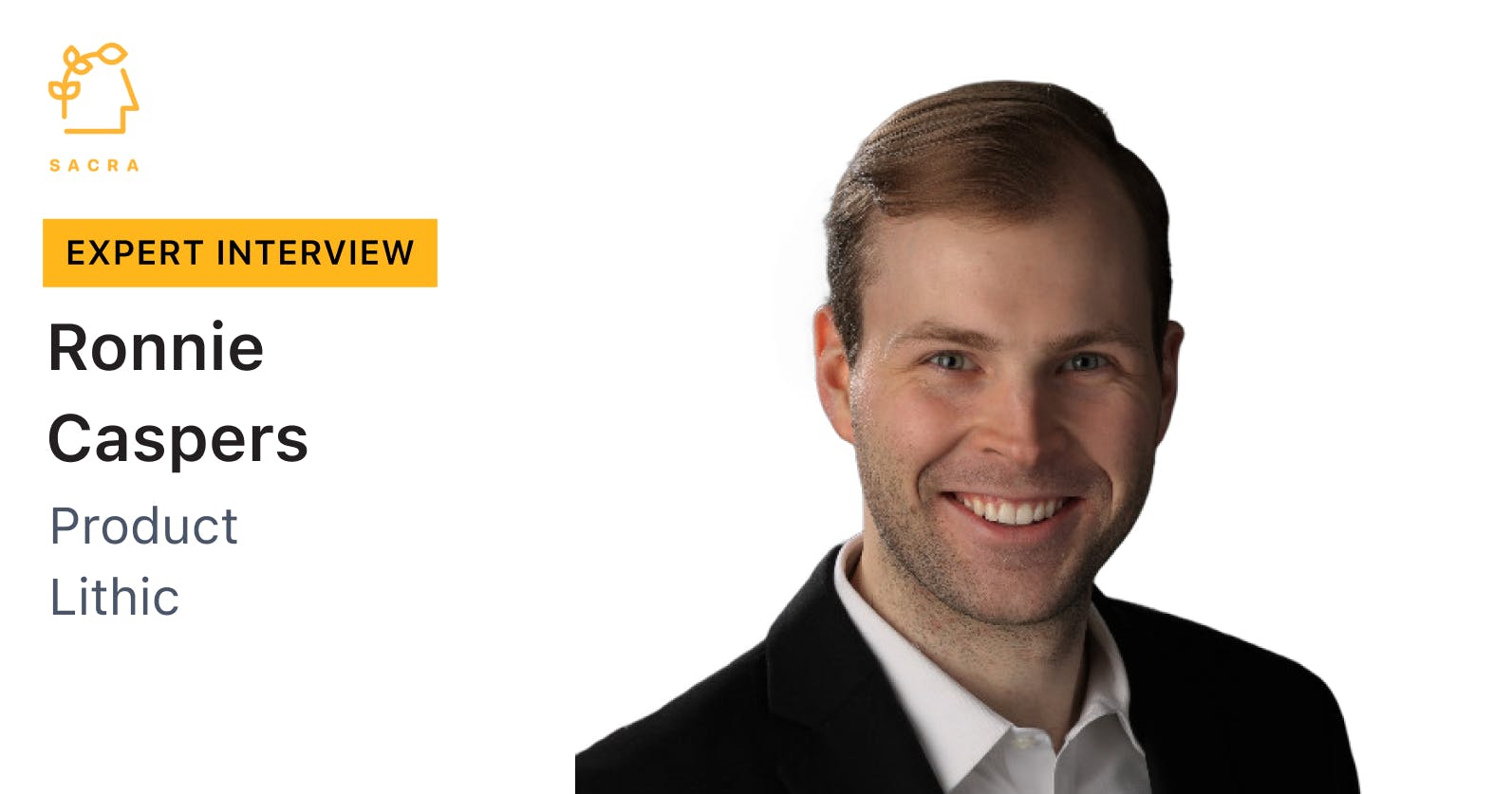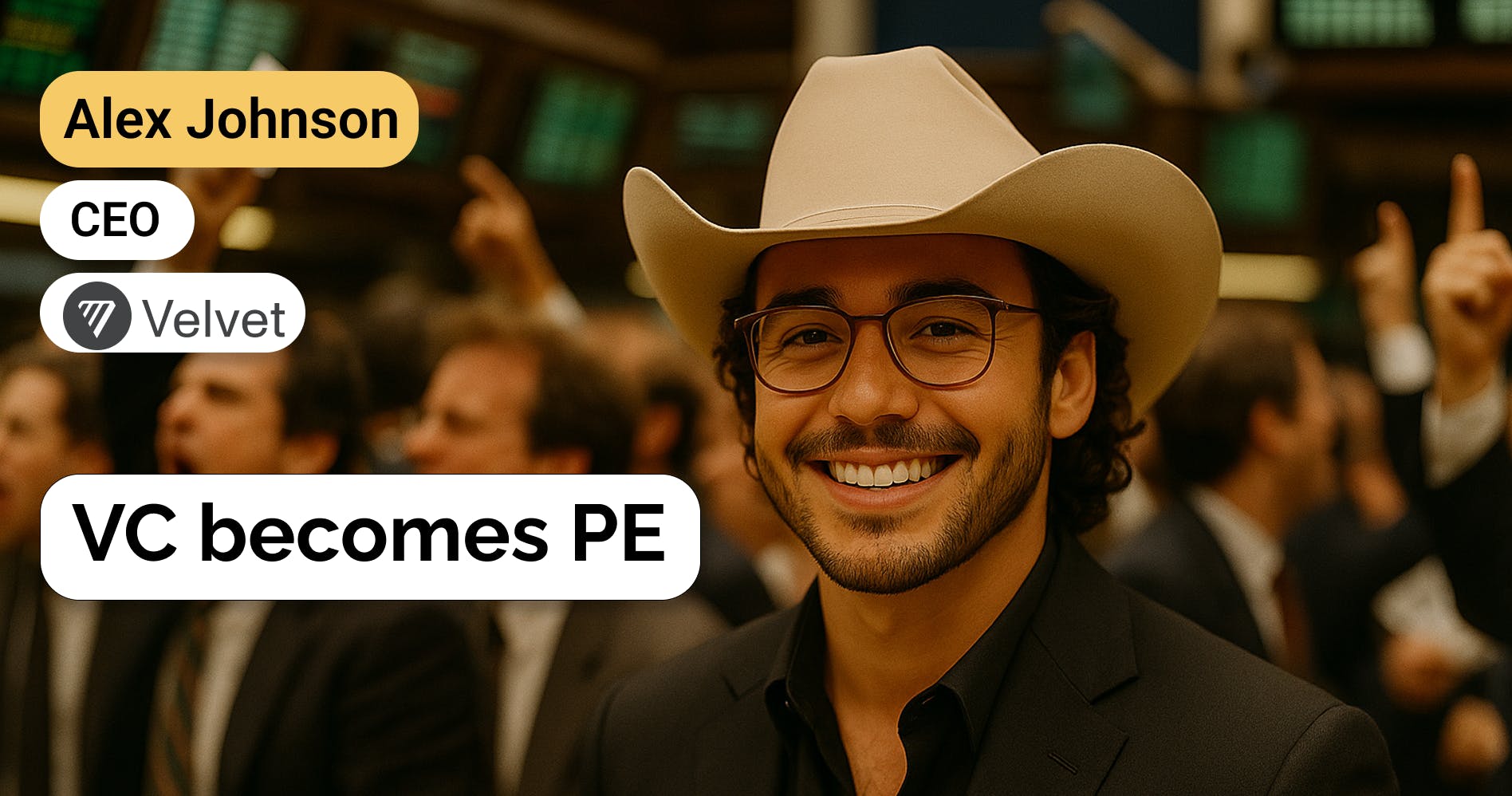Charles Birnbaum, partner at Bessemer Venture Partners, on the five waves of fintech
 Jan-Erik Asplund
Jan-Erik Asplund

Background
Charles Birnbaum is a partner at Bessemer Venture Partners. We talked to Charles about the history of fintech to date, investing in fintech developer platforms and orchestration layers, and where the value will accrue in the fintech market.
Questions
- Could you kick off by just walking us through the five waves of fintech and what you see as the big macro drivers here?
- In the context of themes you mentioned—picks and shovels, developer middleware, enabling embedded fintech and vertical SaaS—can you talk about your investment in Lithic? What excited you about the company?
- You described this pattern of founders who initially had the aspiration to build something for consumers and in the process, realized the need for some underlying infrastructure. They built that and made it available to others. That’s a compelling story around founder market fit and finding your way to the ultimate product. What is your take on an ongoing basis of running both Privacy.com and Lithic, simultaneously?
- You mention Auth0 and what Bessemer has done on the developer-first, B2B side. There's also organic adoption from developers and developer communities advocating for it. In fintech, a developer-first tool enables creativity and it's beyond just middleware. What role does developer advocacy and winning the developer have in a sales-driven go-to-market (GTM)?
- What is your take on banking as a service (BaaS) and its role in enabling embedded fintech?
- You’ve mentioned Alloy as a big example for waves four and five of fintech especially in the context of new orchestration layers. What, in particular, got you excited about Alloy?
- This term orchestration layer may be differentiated both from middleware and universal APIs. With regard to Alloy, the need for an orchestration layer arises from having to fight fraud on an ongoing basis. Also, customers have different workflows and risk tolerance in terms of the balance between growth and fraud. What circumstances make a rich orchestration layer absolutely critical vs. a more universal API approach that's a 100% developer-centric?
- Your focus is on infrastructure that enables novel fintech apps and can support legacy players. But the infrastructure space seems very crowded today. How do you see the fragmentation of infrastructure providers affecting how you think about generating outsized returns as an investor?
- Where do you see generative AI delivering really strong value in fintech?
Interview
Could you kick off by just walking us through the five waves of fintech and what you see as the big macro drivers here?
Early on, we as a firm—long before I got here—were investing in what I would call financial services disruption. I call it that, and not just fintech, because sometimes it’s just based on business model innovation, even if there's minimal IP in the platform or the software or technology.
Two examples of that in our portfolio might be the Gerson Lehrman Group (GLG) and United Capital, which was an RIA roll up that ultimately sold to Goldman Sachs. Those were two investments made by my mentor, Rob Stavis, before I joined the firm, but I was fortunate to learn from.
They were great venture outcomes because they identified a dislocation in the business model in their sectors—in the case of equity research with GLG, and in the other case, with the way RIAs were not leveraging technology or common systems to create leverage for clients and deliver better experiences and advice. In United's case, it was largely about using Salesforce and modern applications well, having consistent practices around client centricity, and lowering the cost of service as the space dealt with fee compression.
Then, after this wave of financial services disruptions, we saw the massive wave of unbundling. First, you had the unbundling of the traditional bank with companies like Betterment in our portfolio, TransferWise (now Wise), SoFi, and so on. There were unicorn private companies minted in each category of the Wells Fargo sitemap, and furthermore in each geography.
While we made some exciting consumer investments during this period in businesses like Betterment, Truebill, Toss, Zopa and others, we didn't participate in that wave as aggressively as others—we were always cautious about how these businesses would ultimately be valued so we evaluated and participated in some early stage rounds, but we didn't really make growth stage investments.
On the other hand, what we consistently focused on as a fintech team was the infrastructure to enable that wave of unbundling and the inevitable rebundling that would follow. Some people would call it the picks and shovels to the fintech gold rush, but it was deeper than that—we were looking for the developer platform for fintechs that delivered hard ROI and magical unlocks for customers, the same kind of thing we had invested in with Twilio, SendGrid, Auth0, and many others at Bessemer.
We looked for emerging market leaders that sold not just to the growing fintechs, but those that could sell to both and could crack the up-and-comers and the legacy incumbents. That, to me, is when you have something that will become mission-critical and facilitate the next wave of innovation. That's also what you'll see in our portfolio today—companies like Alloy, Mambu, Shift Technology, and Lithic and many others.
There are other elements of these waves, too. Vertical SaaS, or industry-specific software, has been a major focus of ours for over a decade. We, as a firm, were a little earlier than others to identify the market size potential for some of these—like Procore in construction, Toast in restaurants, or Brightwheel in the preschool daycare market.
So we applied our vertical SaaS playbook to financial services as well and tried to identify the areas that were most interesting, like the mortgage ecosystem, certain elements of insurance, and obviously bank software and b2b payments.
Lastly, this industry has simply been really slow to move into the cloud. Our payments ecosystem here in the U.S. and largely in Europe is not yet through that transition, and I still think there's opportunity there.
Some of these waves are ongoing, while the B2B payments software wave and a few new ones are percolating, but that's how I would summarize them quickly.
In the context of themes you mentioned—picks and shovels, developer middleware, enabling embedded fintech and vertical SaaS—can you talk about your investment in Lithic? What excited you about the company?
One of my core principles in fintech infrastructure is that—just given all of the stakeholders, the friction, the regulatory constraints, the history, and the nuances—it takes time. Nothing really valuable happens overnight, and Lithic’s story has been consistent with that.
Privacy.com was what Lithic was called before we invested—at the time, it was a great consumer experience for protecting your privacy to purchase things online. That consumer business is still growing nicely and healthy, but what we noticed along with Bo, Jason, and the team was that their API had this natural pull from the market, with a lot of fintechs using it to start issuing cards for interesting new use cases.
They’d exposed the infrastructure they built for virtual card issuance that enabled Privacy.com, that became Lithic, and that's what we invested in. It was really more like a Series A for the B2B business that we led a few years ago. It now powers Mercury, Novo, and some of the real innovative players, particularly in B2B payments.
What makes it a true developer platform is not just that the API docs are publicly available or that it's digestible and well-documented. It's the flexibility.
There are other solutions if you just want to slap a card onto an existing consumer experience, add a debit card or a credit card, or just do card issuing. If you want to differentiate and move money in interesting ways, whether that's payouts, collections, or via virtual cards—and we’re seeing a lot of really interesting use cases here—that’s what we’re seeing Lithic customers doing. Net new businesses are being created because of what they've built.
You described this pattern of founders who initially had the aspiration to build something for consumers and in the process, realized the need for some underlying infrastructure. They built that and made it available to others. That’s a compelling story around founder market fit and finding your way to the ultimate product. What is your take on an ongoing basis of running both Privacy.com and Lithic, simultaneously?
It's a challenge. You have to choose which one to focus on. I think the decision was made to really focus on the Lithic business for a period of time to get it enterprise grade so we could move upmarket where the team was seeing demand.
That being said, when you're not spending a lot of money on marketing, a really talented team of product managers, engineers, and good management can continue to iterate just like a really scrappy early stage startup. That's what we're seeing with Privacy.
It is a little counterintuitive and not the typical playbook, but with that particular business, there's some real benefit from Privacy being customer number one of the platform. The iteration and the learning that started from the beginning there continues to be the sandbox.
You mention Auth0 and what Bessemer has done on the developer-first, B2B side. There's also organic adoption from developers and developer communities advocating for it. In fintech, a developer-first tool enables creativity and it's beyond just middleware. What role does developer advocacy and winning the developer have in a sales-driven go-to-market (GTM)?
With companies like Twilio, SendGrid, and Auth0, that bottoms-up developer and customer love is critical—whether it's showing what's possible with the platform at a hackathon, or by just making very clear in your marketing that the developer is the customer, you have to hit the enterprise from both angles.
You have to have the people who are building the products advocate for you, but you also need enterprise sales once you start closing high six figure and seven figure deals. That's what we've seen over time at those companies, and Alloy, Lithic, and the others in our fintech infrastructure portfolio are going through that same journey.
At Alloy, we have hundreds of customers, but we're also building out a more sophisticated enterprise GTM engine to add more large banks that want to leverage that identity platform for the future. Alloy, essentially, is future-proofing their customers from fraud because fraud is an ongoing constant battle that is always going to have new emerging challenges.
With generative AI and real-time payments coming to the U.S. there's always going to be change. There will be new vendors and with that platform being sold to a bank, you're replacing their internal processes and legacy systems. So, it's a different sale. That being said, if you have a great developer experience, that's going to lubricate the sales process and let the deal happen because you just need a lot of internal champions to close an enterprise deal.
What is your take on banking as a service (BaaS) and its role in enabling embedded fintech?
The BaaS market and the series of companies that offer that out-of-the-box solution have provided a tremendous service to the broader fintech market. There are hundreds of companies that wouldn't be possible or exist without the likes of Unit, Bond, Rize, Synctera, Synapse, etc.
We haven’t made an investment in this category - not because we didn't think they were good companies, but because we have been focused more on companies like Lithic that spike in something, or focus on being best-in-breed at a specific element of the fintech infrastructure stack. We definitely evaluated those BaaS businesses and the growth has been impressive. It’s just that we're super thesis-driven and that's how we thought about it.
You’ve mentioned Alloy as a big example for waves four and five of fintech especially in the context of new orchestration layers. What, in particular, got you excited about Alloy?
Orchestration layers is a term that's tossed around a lot in fintech and beyond, and the nuance between that and the term middleware is important.
Whenever you're evaluating an early stage deal, often, it will just be middleware in the beginning, which can be ok. What we're often trying to do is find a team that's capable of building a rich layer that just delivers tremendous value and ROI for the customer whether that's doing the work that it would take multiple high-cost product managers and engineers to do, or whether it's even clearer.
In the case of Alloy, you can actually see the data on fraud prevention onboarding increasing without a lift in fraud. There's a direct revenue lift that you can associate with the platform. What we look for early on in a seed or Series A or Series B investment is, “Are the customers seeing the clear value from that rich layer? Is it more than middleware that's just connecting the dots? Is it something that you could do internally but just don't want to deal with?”
What Alloy did—and frankly, we didn't lead a Series A until they had both customers in the fintech community and had closed Ally Bank, one of the largest banks in the US that has no physical branches and was making a transition at the time to leveraging the platform—was a watershed moment in a company I'd been tracking for years knowing that they were doing something valuable.
Fraud, in financial services, is a big industry and it's only going to grow. The recent developments in generative AI breakthroughs and the U.S. finally adopting various forms of real-time payments that have long existed in India, Brazil, China, and elsewhere in the world are critical.
There's new kinds of fraud coming that people don't know how to deal with, and there's going to be a whole slew of new vendors that Alloy can integrate.
Long-term, it feels like a really good strategy to me. But just like anything else, good things take time and patience.
This term orchestration layer may be differentiated both from middleware and universal APIs. With regard to Alloy, the need for an orchestration layer arises from having to fight fraud on an ongoing basis. Also, customers have different workflows and risk tolerance in terms of the balance between growth and fraud. What circumstances make a rich orchestration layer absolutely critical vs. a more universal API approach that's a 100% developer-centric?
It depends, because there are some really interesting businesses that are getting a lot of traction in the HRIS market—for instance, companies like Finch and their competitors. That's a data aggregation universal API type problem, just like Plaid and their competitors solved over the last decade. There's a lot of value there.
Once you've done that, however, how do you move beyond to solve something really hard where you can charge your customers a lot more—whether the value’s in the data, in the decisioning, fraud prevention, or so on? That's what you have to look for, and eventually, it just shows up in the contract values for an early stage business. If a customer sees enough value in that orchestration layer to pay up, that's ultimately the data point that shows it. The proof is in the pudding.
Often, the aggregation players and universal API companies get really expansive with many, many customers, but low contract values. That's a difficult thing to pull off unless you're attacking a very large market.
As an early stage investor, when you're doing a B2B deal, you really have to just read the tea leaves of the early customer engagements and what people are actually telling you. We try to connect the dots as to whether or not there's going to be really rich customer value, or if it’s going to be thin, because then you're not going to make money as a company or as an investor.
Your focus is on infrastructure that enables novel fintech apps and can support legacy players. But the infrastructure space seems very crowded today. How do you see the fragmentation of infrastructure providers affecting how you think about generating outsized returns as an investor?
You just have to be really, really careful. It comes back to not underestimating the size of these markets—a mistake I've made in the past—and simultaneously, not underestimating competitive threats.
You just have to be really confident in the team and the differentiation, their approach over the medium- and long-term and be supportive of them in sticking to that path, because ultimately, the enterprise deals—the sticky, really valuable deals—where companies that are durable are building on top of you and you're becoming mission-critical infrastructure to them, just takes time and really unbelievable product development.
There's risk and that's why being an investor is hard. I've gotten a bunch right and I've gotten many wrong. You're hitting on some of the key questions when you're making an early stage investment.
Where do you see generative AI delivering really strong value in fintech?
Generative AI is really exciting. Unlike some other head fakes in paradigm shifting moments of the last few years, this does feel different just in terms of the customers looking for answers, the boardrooms of a P&C insurance carrier, or a bank wanting answers on how they can use this stuff.
There's going to be a series of really interesting software companies built that allow legacy financial services players and up-and-coming fintech and insurtech upstarts to leverage these technology breakthroughs in a way that's compliant.
I've made one investment in that space already—a team out of Unqork that is building a company called Sixfold AI. They're focused on insurance underwriting. There is a very near-term opportunity for entrepreneurs to leverage these recent breakthroughs and deliver immediate value to customers in financial services.
The consumer use cases are also exciting, particularly around financial advice. Finally, having somebody build PFMs that have long been promised and that go beyond what Mint has done and others that have just not even been displaced yet, definitely signals that there’s opportunity out there. But consumer adoption is always really hard. To build a subscription service off of some of these themes is possible, and we're paying attention to that, as well.
Disclaimers
This transcript is for information purposes only and does not constitute advice of any type or trade recommendation and should not form the basis of any investment decision. Sacra accepts no liability for the transcript or for any errors, omissions or inaccuracies in respect of it. The views of the experts expressed in the transcript are those of the experts and they are not endorsed by, nor do they represent the opinion of Sacra. Sacra reserves all copyright, intellectual property rights in the transcript. Any modification, copying, displaying, distributing, transmitting, publishing, licensing, creating derivative works from, or selling any transcript is strictly prohibited.












